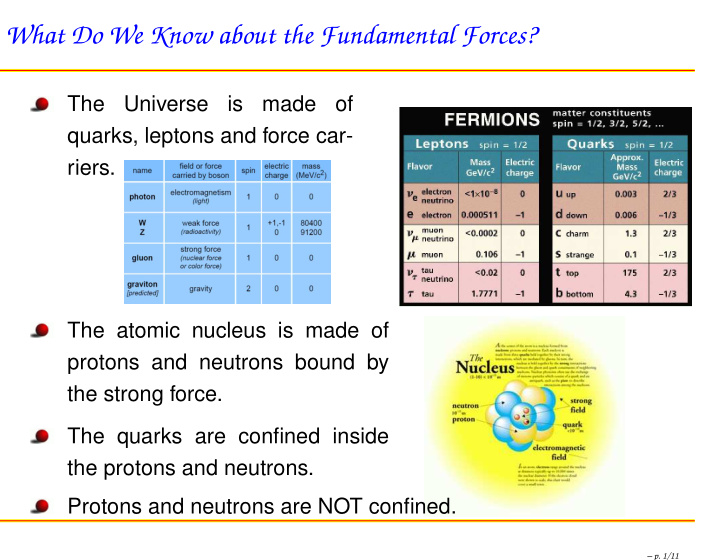



What Do We Know about the Fundamental Forces? The Universe is made of quarks, leptons and force car- riers. The atomic nucleus is made of protons and neutrons bound by the strong force. The quarks are confined inside the protons and neutrons. Protons and neutrons are NOT confined. – p. 1/11
The Electric and Magnetic Fields? dq ˆ r d � E = k e r 2
The Electric and Magnetic Fields? dq ˆ r d � E = k e r 2 d � B = k m Id� s × ˆ r r 2 – p. 2/11
The Magnetic Field of a Current Loop Consider a circular loop of radius R located in the y − z plane and carrying a steady current I . What is the magnetic field at an axial point P a distance x from the center of the loop in terms of I , R , x , and any other constants? I R P x – p. 3/11
The Magnetic Field of a Current Loop – p. 4/11
How the Sensor Works - The Hall Effect – p. 5/11
How the Sensor Works - Electric Current – p. 6/11
Fitting the Data 14 70 12 f � x � � 2.39 � 0.298x 10 60 Variance 8 50 f � x � 6 40 4 2 30 Estimated 0 0 5 10 15 20 25 20 x 10 0 0.27 0.28 0.29 0.3 0.31 0.32 Slope In the plot above the value of the y -intercept is kept at its best fit value and the slope is varied. The estimated variance is the following. � N i =1 ( y i − ( mx i + b )) 2 σ 2 = N − d.o.f where N is the number of data points and d.o.f is the number of degrees of freedom ( i.e. free parameters) in the fit. – p. 7/11
Using the Reduced χ 2 pA → e + e − X The χ 2 and reduced χ 2 are N (( y i − f ( x i )) 2 χ 2 = � σ 2 i i =1 and χ 2 reduced χ 2 = N − d.o.f where N is the number of data points. In Mathematica the estimated variance is equal to the reduced χ 2 if the proper weighting is used. R. Muto et al. , Evidence for In-Medium Modification of the φ Meson at Normal Nuclear Density , Phys. Rev. Lett., 98 , 042501 (2007). – p. 8/11
Using the Pasco Hall Probe – p. 9/11
Biot-Savart Results Magnetic Field of a Current Loop 0.00025 Red: Data Blue � Dashed: Varying n 0.00020 Light � Blue � Solid: Predicted 0.00015 B � T � 0.00010 0.00005 0.00000 0.00 0.05 0.10 0.15 0.20 0.25 r � m � – p. 10/11
Averaging a Data Range in DataStudio Zoom in on the data range of interest. Click on Selected Statistics in the DataStudio menu bar. Check ‘Min’, ‘Max’, ‘Mean’, and ‘Standard Deviation’. Click and drag to high- light the points of inter- est. The results will be Double click to displayed in a box on the format statistics Selected Statistics plot. To change the output format in the statistics box, (1) Double click on the data set listing (see ‘Data’ window on the left), (2) choose the ‘Nu- meric’ tab and (3) modify the ‘Style’ menu to suit. – p. 11/11
Recommend
More recommend